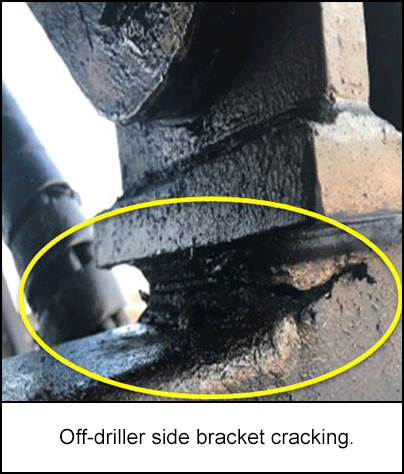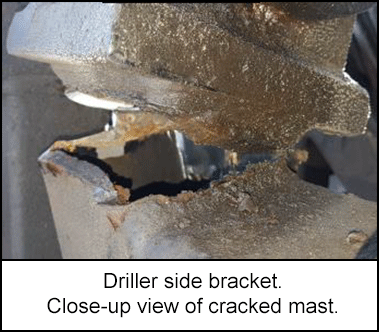-
What happened?
The crew was lowering a slant rig mast and heard a ‘pop’.
The mast was leaning towards the side of the carrier.

-
Why did it happen?
A third-party inspection revealed two weld failures at the brackets that pin the mast to the A-frame.
Contributing factors:
- Previous engineering quality control, assurance and repair added to the difficulty for inspection.
- Workers required a higher level of inspection experience to recognize cracking in the welds.

-
What did they learn?
Regular Level I and II inspections as per the CAODC recommended practice did not include inspection the welded areas under the mast brackets.
Some corrective actions were taken:
The company had been following the CAODC Canadian Well Servicing Industry; Recommended Practice 3.0: Inspection and Certification of Masts (SR), including the hours of service inspection intervals. More frequent Level III inspections may have brought attention to cracks in the mast by the A-frame.
The company focused on the following actions:
- Engineers certified in Level III and higher inspections will train field supervisors, rig managers and drillers for awareness of overall component inspections.
- Rig managers and drillers will continue to perform Level II inspections of entire mast structures, paying special attention to the carrier, ears, mast derrick pins and A-frame.

-
Ask yourself or your crew
- How can something like this happen here (e.g. on our site)?
- What safety measures (i.e. procedures, controls/barriers) do we have in place to mitigate the risk?
- How do we know the risk controls/barriers are working?
- What improvements or changes should we make to the procedures, controls/barriers or the way we work?

Add to homescreen
Content name
Select existing category:
Content name
New collection
Edit collection
What happened?
The crew was lowering a slant rig mast and heard a ‘pop’.
The mast was leaning towards the side of the carrier.

Why did it happen?
A third-party inspection revealed two weld failures at the brackets that pin the mast to the A-frame.
Contributing factors:
- Previous engineering quality control, assurance and repair added to the difficulty for inspection.
- Workers required a higher level of inspection experience to recognize cracking in the welds.

What did they learn?
Regular Level I and II inspections as per the CAODC recommended practice did not include inspection the welded areas under the mast brackets.
Some corrective actions were taken:
The company had been following the CAODC Canadian Well Servicing Industry; Recommended Practice 3.0: Inspection and Certification of Masts (SR), including the hours of service inspection intervals. More frequent Level III inspections may have brought attention to cracks in the mast by the A-frame.
The company focused on the following actions:
- Engineers certified in Level III and higher inspections will train field supervisors, rig managers and drillers for awareness of overall component inspections.
- Rig managers and drillers will continue to perform Level II inspections of entire mast structures, paying special attention to the carrier, ears, mast derrick pins and A-frame.
Ask yourself or your crew
- How can something like this happen here (e.g. on our site)?
- What safety measures (i.e. procedures, controls/barriers) do we have in place to mitigate the risk?
- How do we know the risk controls/barriers are working?
- What improvements or changes should we make to the procedures, controls/barriers or the way we work?
The crew was lowering a slant rig mast and heard a ‘pop’. The mast was leaning towards the side of the carrier. A third-party inspection revealed two weld failures at the brackets that pin the mast to the A-frame.
Original material courtesy of Energy Safety Canada
![]()

Other external resources: CAODC Level III Inspection Checklist












